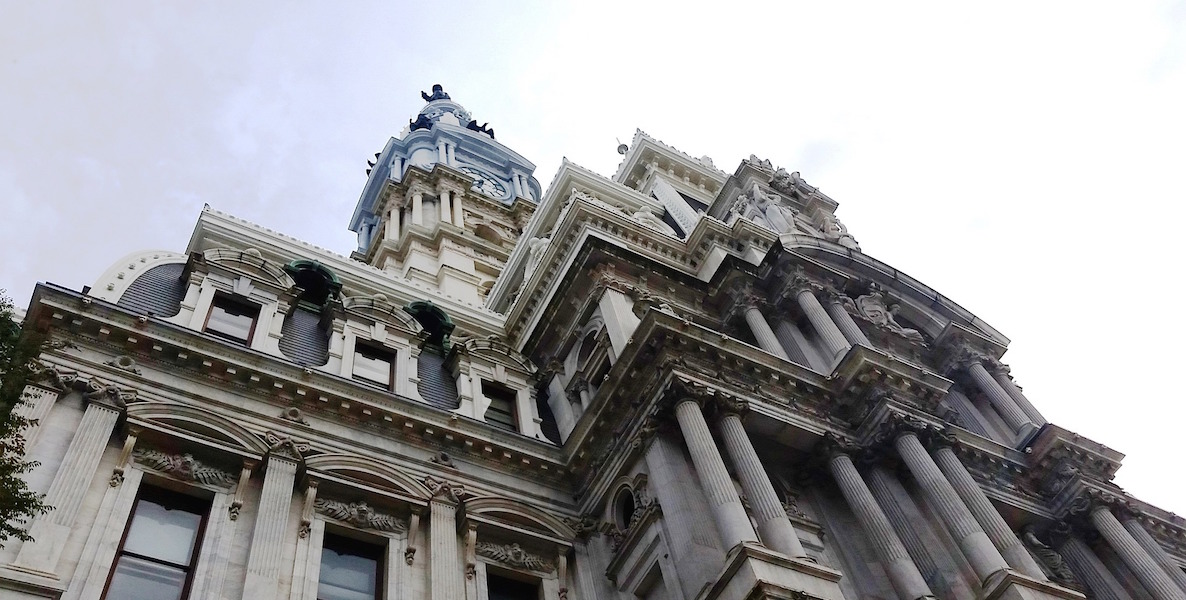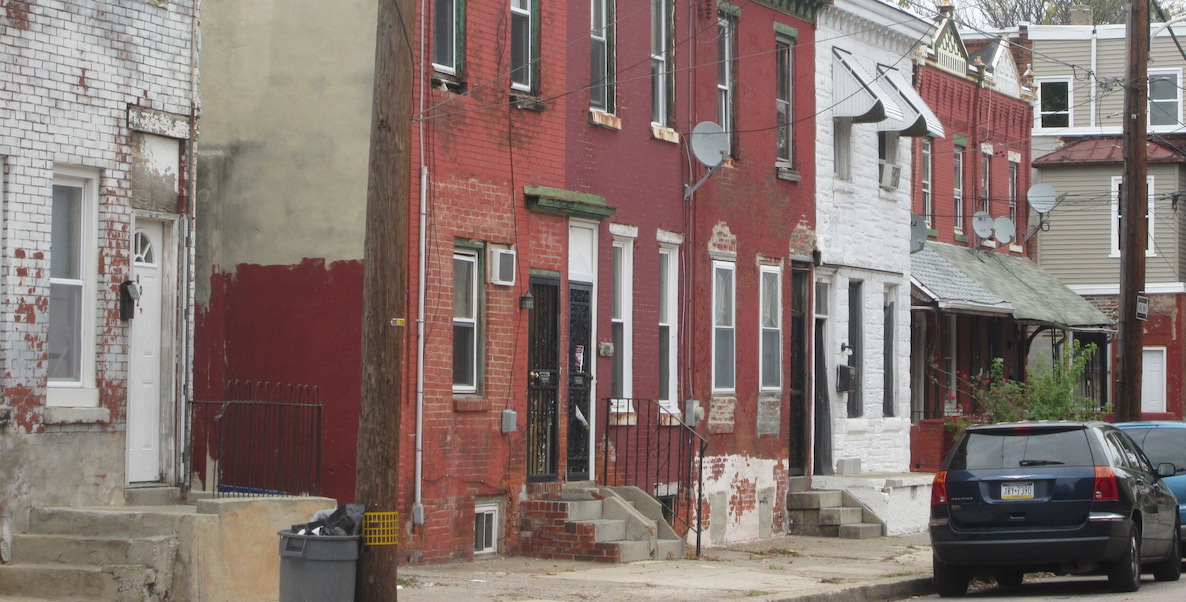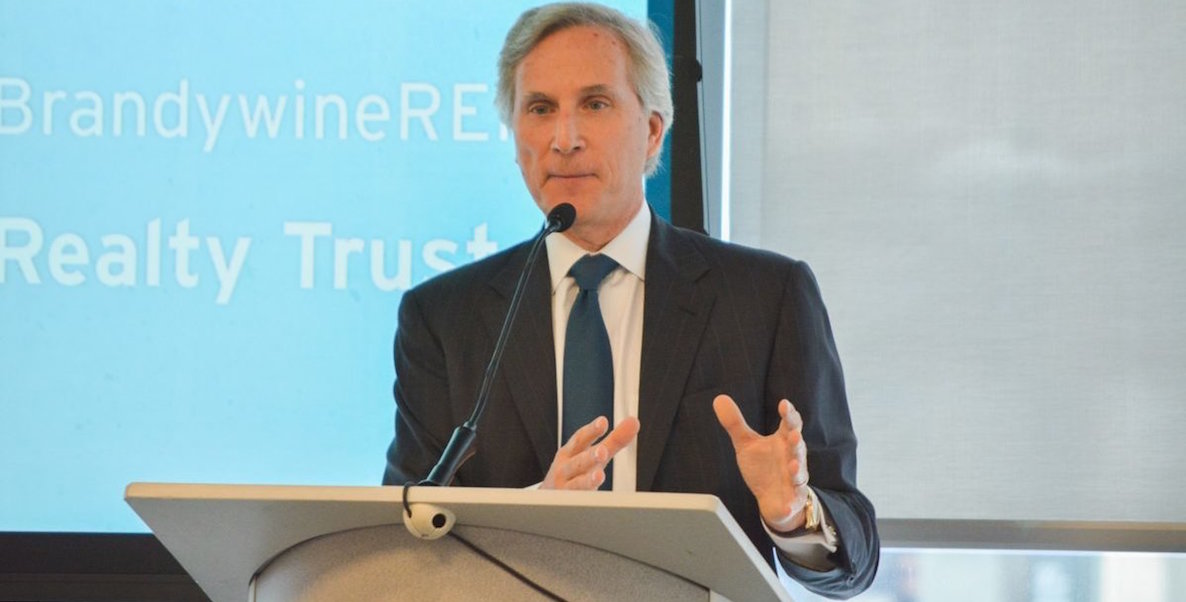A couple of years ago, I found myself at a nerdy conference about the life of cities, and I heard Kasim Reed, the-then mayor of Atlanta, say something that helped me zero in on a fundamental Philadelphia challenge. I don’t really run things in Atlanta, he said, identifying a “kitchen cabinet” of business leaders—the CEOs of companies like Coca-Cola, Home Depot and Turner Broadcasting—to whom he’d defer on the strategy of growing local jobs.

Prefer the audio version of this story? Listen to this article on CitizenCast below:

Who, after all, knows more about stimulating growth than titans of industry? They’d tell him what to do as he pursued his “bigger pie strategy,” an economic plan that resulted, by the end of Reed’s two-term tenure last year, in Atlanta’s GDP outperforming that of most states.
We don’t have that in Philly, I thought, an engaged business class that’s unafraid to lead. Here, we’ve long had a timid Chamber of Commerce in what has become more of a branch-office town; the result has been a business community that—far from lending its expertise to local government and then making sure its recommendations actually happen—defers to elected leaders committed to doing just enough to get through the next election.
Be Part of the Solution
Become a Citizen member.One such business macher, however, has had the temerity to stick his head above the go-along-to-get-along pack. Last month, there he was before the aforementioned Chamber, making his case for a bold reform to our tax structure in order to grow jobs. Today, there he is alongside Paul Levy, Center City District CEO, walking business leaders and journalists through the numbers of the CCD’s eye-opening report—released today—about the economic health of our city.
And there he was, a couple of weeks ago, high atop the FMC Tower at his Cira Centre South skyscraper in University City, when I caught up with him. Over a wide-ranging hour-long discussion, Jerry Sweeney, CEO of Brandywine Realty Trust, gave voice to more vision, and more can-do spirit, and more smart long-term policy prescriptions for Philadelphia than any elected leader of at least the last two decades.
“We’re one of the biggest commercial landlords in Austin, Texas, and I always leave that city walking a little bit faster,” Sweeney, 61, told me, sitting on a sofa in a living-room like corner office. “Everybody there says, ‘We can do that.’ They say, ‘It won’t be easy, but we can do it.’ That’s juxtaposed against the status-quo protectionist vision you see in Philadelphia, where the attitude is often, ‘We’ve never done it that way—that will be risky.’ The fundamental issue we have in Philadelphia is that the political community and the business community have to believe in the success of Philadelphia. There’s never been a successful public policy that hasn’t been driven by the objective of growing. How can you have a city with a historically high unemployment rate, historically low median income, historically high poverty, historically deep poverty, and not look at that and say, ‘We need jobs’? Honestly, it’s amazing to me the amount of time we spend in public debate figuring out how to triage symptoms, as opposed to figuring out what’s the fundamental problem.”
And so, a couple of years ago, Sweeney and Levy announced the Philadelphia Jobs Growth Coalition. With support from organized labor, the Mayor, the African-American and Hispanic Chambers of Commerce, and good government groups like Committee of 70, they brilliantly identified the folly of the city’s tax structure.
“How can you have a city with a historically high unemployment rate, historically low median income, historically high poverty, historically deep poverty, and not look at that and say, ‘We need jobs’?”
In short: We tax what can move (people and jobs), instead of what can’t (commercial real estate). So here’s Sweeney, a commercial realtor, arguing that we should tax him more, for the good of the city. The only caveat, according to Sweeney and Levy: The proceeds of said tax should be invested into further reductions of wage and business taxes, rather than reverting to the general fund. It has to be a jobs growth plan, Sweeney says— not a government growth plan.
The Sweeney/Levy plan, essentially, calls for a change in the state’s uniformity clause that would give the city the authority to tax commercial real estate 15 percent higher than residential homeowners. That revenue, in turn, would be used to cut the wage tax to below 3 percent by 2025 and cut the net income portion of the Business Income & Receipts tax in half during the same time frame.
With such a plan, Philadelphia might finally find itself on competitive footing with its suburbs, as well as nearby cities. (Of the biggest 25 cities, we are a lowly 23rd in terms of job growth). We would no longer be incentivizing people and jobs to flee the city. (Currently, according to Levy’s report, 211,000 Philadelphians reverse commute to jobs outside of Philadelphia).
As Jeremy Nowak wrote here when Sweeney and Levy first rolled out their plan, “At the heart of this proposal are commercial building owners willing to advocate for a rise in their own tax rate. They believe in the economics of the proposal enough to assume an eventual rise in asset value and demand, which will more than compensate. But it is a risk. In the meantime, their increased tax rate is what the city needs to make it all work.” He went on to praise Sweeney, for his willingness to take such a visible role. “That is a very un-Philadelphia thing to do,” Nowak wrote. “The last business leader to play this kind of civic role was Willard Rouse.”
Here’s Sweeney, a commercial realtor, arguing that we should tax him more, for the good of the city. The only caveat: The proceeds go into further wage and business tax cuts, rather than the general fund. It has to be a jobs growth plan, Sweeney says—not a government growth plan.
That was two years ago. Back then, Sweeney may not have realized the long slog he was in for. Changing the state constitution’s uniformity clause requires getting through two legislative sessions—they’ve made it through one—and then passing a public referendum. On that score, the increasing scarcity of moderate Republicans statewide might not bode well. Meantime, the finger-to-the-wind Chamber was for the plan…before it was against it. And Darrell Clarke says he’s all for taxing commercial properties higher, but wants that revenue returned to the general fund. In other words: More bloated bureaucracy, more anemic job growth.
“I had someone call me this morning who was fairly critical of our plan, and I said, ‘You know what? Where’s your jobs plan?’” Sweeney says when the subject of such roadblocks come up. “I view our proposal as something that has a tremendous amount of merit. But it really is, fundamentally, a challenge to our public officials to say, ‘Okay, you don’t like this. Where’s your plan?’ The city’s number one policy goal, through which every piece of legislation should be evaluated, should be, ’Does this grow jobs? Is this an opportunity for the city to become a top five job generator in the country over the next 10 years?’ When you think about what we have here—the educational institutions, the neighborhoods, the transportation, the access—this city needs to be unleashed by strategic, rather than tactical, thinking.”
When you combine our historic poverty levels with the recent boom in both Center City and University City, it’s tempting to think of our economic story as the quintessential tale of two cities, but Levy says that would be wrong. “We’re a tale of one city not growing fast enough,” he says. He points out that Philadelphia, Boston and New York all lost roughly the same percentage of manufacturing jobs since 1970; it’s only Philly that hasn’t figured out a way to recover since then.
Sweeney and Levy work so well together because they each fill critical roles: Sweeney is the big vision guy, Levy the wonk. But both also get things done: Sweeney founded Brandywine in 1994 and built it into a national player, and Levy has been more responsible for Center City’s boom than anyone. He’s refurbished city parks—including Dilworth Plaza, the gateway to City Hall—and cleaned up once-filthy city streets. Under Levy, the CCD has also become something of a local think tank, releasing reports and advancing game-changing ideas.
It’s Levy the wonk who schools me on the purpose of taxes. There are two, he says. One is to generate revenue; we need taxes to support city services and schools. That’s the purpose a succession of tax-happy mayors have focused on, culminating in Kenney, whose promiscuity seems to know no bounds; has he seen a tax he hasn’t lusted to enact?
![]() “But in other cities, against whom we compete, taxes have also been used to create a climate for growth by creating competitive conditions,” so that taxes in Philly are at around the same levels as other cities in the region and country, Levy says. It’s that second part our elected officials haven’t paid attention to, and the business community has been loathe to argue for.
“But in other cities, against whom we compete, taxes have also been used to create a climate for growth by creating competitive conditions,” so that taxes in Philly are at around the same levels as other cities in the region and country, Levy says. It’s that second part our elected officials haven’t paid attention to, and the business community has been loathe to argue for.
Ironically, over a decade ago, you would have been hard-pressed to predict a partnership between Sweeney and Levy. Sweeney’s Brandywine is now the owner of more commercial property than any company in the city, but he’d been a suburban developer in the early aughts when, taking advantage of a Keystone Opportunity Zone tax break, he built the Cira Centre at 30th Street.
Levy joined the opposition to Brandywine’s use of that tax break on two fronts. Predictably, his critique came from his perspective as a protector of Center City’s economic interests, but he also mounted a wider public policy argument: Such breaks were bad policy if the ultimate result was to entice companies from one part of the city to relocate to another.
Sweeney won that round, but took note: “He’s a smart guy.” As Sweeney started building more and more in Philly, he found himself increasingly having to sell the city to investors and prospective tenants, who wanted to know what the plan was for overcoming its slow growth and high taxes. “It became very clear that being an advocate for a pro-growth agenda was very much a part of our business strategy,” Sweeney says.
When that vision wasn’t forthcoming from the tax-happy, incrementally-focused political class, he convened a group of thoughtful private sector leaders for a series of discussions. At one, it became clear that he and Levy were speaking the same language, after all.
”What sets Jerry apart is he’s all about increasing demand,” Levy says. “Brandywine is a national player, so by definition, he’s not parochial. He constantly has to benchmark Philadelphia versus other cities he’s in. He’s an example of how the more we have people come in from outside the city, the healthier the city will be.”
Sweeney knows that good things come from demand. “Whether you’re in retail, parking, hotels, apartments, condos or office space, you’re in a demand-driven business,” he says. “The more demand there is, the better your business does. The better your business does, the more people you employ, and the better the city does.”
That’s why Sweeney has so wholeheartedly embraced placemaking, creating public spaces that, as he puts it, “are an integral part of creating a community where people want to be.”
Think of it: Sweeney didn’t just erect the Cira Centre South tower. He created a “vertical neighborhood,” spending $12 million creating Cira Green—a sprawling rooftop green space—and another $10 million for its beer hall and restaurant. “When you’re trying to create a neighborhood, you must invest in public spaces,” he says. “Whether it was attracting FMC here, or other tenants, their first concerns were ‘Where do I eat lunch? Where do I walk? Where is there green space?’ In the context of a billion dollar development, creating those spaces is disproportionally valuable to us.”
When Jane Jacobs wrote that “You can’t rely on bringing people downtown, you have to put them there,” she likely didn’t know she was speaking to future generations of developers like Sweeney, who heard in her urban planning critique a calling that aligned with their enlightened self-interest.
That’s why Sweeney’s piece de resistance, the $3.5 billion, 14-acre development of Schuylkill Yards in the shadow of 30th Street Station, is so ambitious. It will have residential and commercial spaces, innovation laboratories, hotels and green space galore. “Of the 14 acres, we’ve master-planned that 6 will be green space,” he says. “We actually believe it’s the best development site in the country.”
Really, all that Sweeney is doing now is a new spin on an old idea. When Jane Jacobs wrote in The Death and Life of Great American Cities that “You can’t rely on bringing people downtown, you have to put them there,” she likely didn’t know she was speaking to future generations of developers like Sweeney, who heard in her urban planning critique a calling that aligned with their enlightened self-interest.
We live in a time when large-scale developers have become de facto celebrities; hell, one is even in the White House, incredulously. Locally, the same holds true. When Bart Blatstein builds a house in Center City, it’s somehow news.
![]() But Sweeney isn’t the swashbuckling type. He’s unassuming; when I reached out and said I wanted to write about him, he begged me to talk to others instead—supporters like the Committee of 70’s David Thornburgh and Steven Bradley, CEO of Bradley & Bradley Associates, a commercial, property and risk management firm. He exudes an “It’s not all about me” demeanor; in that sense, he just might be our foremost accidental disruptor.
But Sweeney isn’t the swashbuckling type. He’s unassuming; when I reached out and said I wanted to write about him, he begged me to talk to others instead—supporters like the Committee of 70’s David Thornburgh and Steven Bradley, CEO of Bradley & Bradley Associates, a commercial, property and risk management firm. He exudes an “It’s not all about me” demeanor; in that sense, he just might be our foremost accidental disruptor.
But standing up and speaking out is what Sweeney learned growing up in Upper Darby. There, in the heart of the vaunted Delaware County Republican machine, Sweeney marveled at how his parents, John and Dolores, went against the grain. Dolores was a Democratic Committeewoman. During election season, she’d put out yard signs; the next morning, they’d all be gone. John was the first Democrat elected to the State Senate since the Civil War when he beat Joe Loeper in 1975. (Loeper, now a lobbyist, went on to become the Senate Majority Leader before going to jail for falsifying tax returns.)
It was his father who provided some tough love lessons in the art of persistence. The Sweeneys spent their summers near Wildwood, where, each June, Jerry and his brother would have to walk the two miles of the boardwalk to secure a job. If they got one, their father would pick them up. If not, they were walking back home, mission unaccomplished. Ultimately, Jerry and his brother found gainful employment at a restaurant owned by Holocaust survivors: “More life lessons,” he says.
“Growing up, it was inculcated in me and my three brothers and two sisters,” Sweeney says. “The value in what we do lies in the difference we can make. That’s why, at Brandywine, we require all of our executives to be on at least one or two nonprofit boards. That’s part of our annual review. It makes no sense for us to make the most architecturally significant building in the country in a city that is not on the upswing.”
Sweeney’s everyday demeanor may be understated, but when it comes to his city, he morphs into an evangelist. When I ask about his pitch for Schuylkill Yards, he launches into the excited expression of a wider vision for the city. He lurches to the edge of his seat; he starts speaking in italics, hands gesticulating, words coming faster.
“We start out talking about how every city has an innovation center now,” he says. “That’s the buzzword. Well, when you think about it, 21 blocks from here 250 years ago, a group of people who could barely agree on anything got together, and they debated, they conciliated, they argued, and they invented Democracy. We are the first innovation city in the world because we invented Democracy. It’s amazing how that resonates with people.”
Finally, it’s time to leave, but Jerry Sweeney is all revved up. He’s telling me how energized he is talking to and learning from the city’s influx of millennials, how they share that “can-do” approach that has long been in short supply here. But, he worries, if we’re not intentional about our growth, we’re going to let them down. “They can become disaffected,” he says. “We have a huge responsibility to keep them motivated and engaged and wanting to stay here.”
And then, shaking my hand, Jerry Sweeney says something you wish you heard more elected officials say, something laced with urgency and ambition: “We can’t waste this moment.”
Photo Courtesy of Greater Philadelphia Chamber of Commerce






